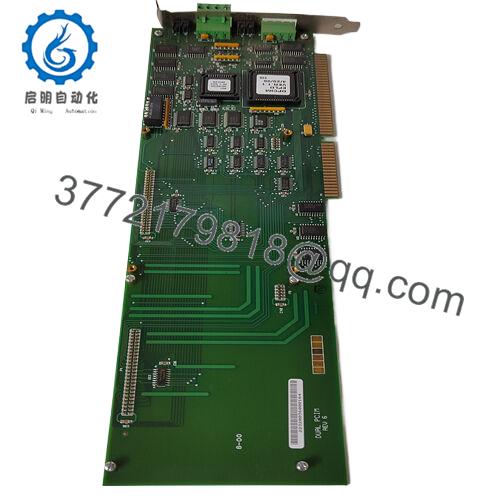Description
In the labyrinth of legacy industrial networks, where host systems like supervisory PCs must interface seamlessly with field I/O over expansive serial buses—yet grapple with integration hurdles like protocol mismatches or expansion limits that spawn data silos and diagnostic dead-ends—engineers face the perennial bind of retrofitting without ripping out proven infrastructure. The GE IC660ELB921M cuts through as a single-channel PCIM (PC Interface Module) from GE Fanuc’s Genius I/O arsenal, squarely addressing the imperative for reliable bus access in industrial automation by linking IBM PC/AT/XT hosts to the Genius LAN, enabling controller-grade oversight of distributed devices. Visualize a sprawling conveyor network in a logistics hub: remote drops of sensors and relays chatter status bits, but without a dedicated tap, the central PC struggles to poll them amid baud rate variances or noise bursts, inviting latency that cascades into stalled pallets or overlooked faults. This module rectifies that by embedding a daughterboard for direct Genius bus coupling, facilitating bidirectional data flows—up to 8,000 inputs and outputs—while enforcing error-checked transactions for up to 30 devices, all tuned for high reliability in I/O signal paths. It’s a staple in process control setups craving modular integration, such as bridging SCADA overlays to Genius drops in water treatment basins or upgrading material tracking in automotive lines where system stability hinges on fault-tolerant handshakes. Zeroing in on the engineer’s core objective of unencumbered scalability, the GE IC660ELB921M obviates the need for custom drivers or multi-board sprawl, letting teams extend control without exhaustive validation. In pump stations, it holds sway during surge events, relaying analog thresholds to avert overflows under humid, EMI-laced conduits. This surpasses simple connectivity; it’s a conduit to cohesion, paring the integration snags that inflate MTTR in heterogeneous grids. For appraisers navigating interfaces in Genius architectures, the GE IC660ELB921M aligns for its protocol fidelity and low-overhead design, sketching a lean trajectory to resilient process control that honors legacy footprints like ISA bus compatibility sans wholesale migrations. Whether tethering a lone workstation or federating a plant-floor constellation, it bestows the bandwidth to evolve from isolated polls to orchestrated intelligence.
- IC660ELB921M
The GE IC660ELB921M embodies a streamlined gateway in the Genius ecosystem, a single-slot ISA card that mates the host PC’s backplane to a solitary Genius serial bus, channeling commands and feedback with the determinism of a native controller. Install it in an available expansion slot of an AT/XT chassis, and it initializes: the onboard 32-bit microprocessor—paired with dual-port memory—scans the bus at configurable rates up to 153.6 kbps, ingesting discrete or block data from drops like IC660BBD modules before mirroring it to the PC’s memory space for application access, all via the supplied configuration utility that tunes drops independently. Situated at the nexus of the automation stack—straddling the host layer and field periphery—it arbitrates traffic, injecting CRC checks and token passing to quarantine faults, while supporting input-only modes to lighten loads on read-heavy setups. In bus-extended arrays, it proxies up to 30 nodes, timestamping exchanges for basic sequencing without ancillary clocks, and diagnostics surface via LED indicators or serial queries to flag bus-offs or parity slips, arming users with proactive pings minus invasive scopes. Dock it with Genius-compatible I/O blocks or handheld monitors in the network, and it enriches the PC’s runtime with polled payloads, embracing SNP protocols for ties to programming tools like Logicmaster. Its pragmatic polish emerges in the setup ritual; the bundled software partitions memory and baud without arcane recompiles, distilling onboarding from ordeals to outings. For amalgam sites layering Ethernet fronts over serial spines, the module’s isolation buffers transients, forestalling the ripple of ground shifts that undo unshielded spans. Collectively, it scaffolds a tiered tableau—host for harnessing, interface for ingress, drops for discernment—fostering extensible spans that adapt from bench prototypes to dispersed deployments. This rapport not only quickens glitch grapples but also accommodates firmware flashes, syncing with persistent connectivity creeds.
| Specification | Details |
|---|---|
| Model Number | IC660ELB921M |
| Brand | GE Fanuc (General Electric) |
| Type | Single-Channel PC Interface Module (PCIM) |
| Input Voltage | 5 V DC (from PC backplane) |
| Operating Temp Range | 0°C to 60°C |
| Mounting Style | ISA slot in PC/AT/XT chassis |
| Dimensions | 233.35 mm (H) × 167.64 mm (W) × 38.1 mm (D) |
| Weight | 1.81 kg |
| Interface/Bus | Genius serial bus; ISA backplane |
| Compliance | CE, UL; ISA compatible |
| Supported Protocols | Genius, SNP |
| Typical Power Draw | 5 W |
Adopting the GE IC660ELB921M confers a quiet revolution in bus mastery, as its single-channel focus—bolstered by a 32-bit core—sustains poll cadences through cable runs exceeding 1,000 m or noisy shop floors, conjuring a warehouse where drop statuses stream sans skips, reclaiming cycles that once vanished to retransmits and bolstering pick accuracies by margins. This vigor begets interpretive insights; by caching block data in dual-port buffers, it feeds custom apps with granular histories, empowering scripts to divine trends like jam hotspots before they jam queues, habitually halving alert volumes in vigilant vigils. Provisioning pains wane as the ISA footprint hugs legacy slots without adapter stacks, infusing Genius reach via a daughterboard snap over chassis churns, tucking enhancements into off-peak overhauls.
Tenacity amid tumult underscores its utility, with error vectors under 0.1% that anchor exchanges even as drops fluctuate—crucial for conveyor spans where token losses could desync mergers, locking in handoffs that sustain hourly tallies. Vigilance veers to value; built-in parity relays cue host logs on anomalies, demystifying a bus collision in breaths over baud hunts, which might economize debug days by doubles in stretched setups. Tempered for tenure with ESD veils and thermal sinks, it avows drift-scarce service that endures beyond ephemeral links, anchoring investments in infrastructural ebbs. For cartographers of connectivity, its drop affinity streamlines node nests, fending off frontiers like hybrid OPC bridges without foundational fumbles. At heart, the GE IC660ELB921M reimagines interfacing from interlock to impetus, meting the mediation and mettle that elevate Genius guilds from granular to grand.
The GE IC660ELB921M lodges securely in discrete assembly realms like electronics fabs, where it proxies PC oversight to feeder drops for component placers, upholding critical system uptime via serial sweeps that pierce solder fumes and static zaps testing token trails. In these process control environments, its block handling marshals 128+ points for stutter-free sorts, quelling misfeeds that mothball machines mid-shift. Bulk material silos in mining ops etch another enclave, with the GE IC660ELB921M in host terminals querying level discretes amid dust devils and vibration veils, where continuous uptime underpins loadouts from lulls. Here, CRC cloaks quarantine noise from crushers, affirming I/O signal high reliability for spill-safe surges. HVAC control clusters in commercial builds cap the cadre, the module in workstation hubs polling damper actuators against airflow anomalies and occupancy fluxes, facilitating zonal tweaks that trim energy draws in variable vents. Spanning these used in power plants and process control environments—albeit primed for discretes—it bridles harsh conditions, magnifying high reliability for ventures valuing vintage vigor.
IC660ELB922 – Dual-channel counterpart for simultaneous Genius bus access in multi-network hosts.
IC660ELB912 – Compatible daughterboard for enhanced drop configuration in single PCIM setups.
IC660BBD020 – Binary input block extending field sensing with the ELB921M’s bus.
IC660BBD120 – High-speed counter module pairing for motion tracking via Genius taps.
IC693CMM302 – Serial comms card for SNP bridging in 90-30 PLC integrations.
IC660EBD120 – Electronic block driver for analog expansions alongside PCIM interfaces.
IC660BBS103 – Bus switch module for segmenting drops in ELB921M-extended spans.
Before committing the GE IC660ELB921M to your ISA slot, audit bus occupancy—AT chassis with crowded expansions can warp signals if ground planes overlap; a DMM sweep for <0.1 Ω continuity nips latent hums that feign drop silences. Daughterboard seating demands scrutiny too; misaligned pins on the IC660ELB912 invite init fails, so a torque wrench at 0.5 Nm secures without stressing traces. Config parity via the utility pre-boot—mismatched baud or drop maps trigger token ejects, stalling the scan; reload from floppy to harmonize with host IRQ. Nurture narrows to nuance: bimonthly bus probes with a terminator tool unearth reflections in daisy chains over 120 Ω, paramount in EMI-burdened bays; spikes beyond 10% cue stub trims to reclaim rate fidelity. Annual token tests, injecting mock globals from a monitor, assay response spreads sans live loads—variances past 2 ms hint at cable creep, ripe for swaps. In conductive climes, conformal sprays on edge fingers merit seasonal checks; oxidation hiking contact resistance over 50 mΩ invites intermittent polls. These aren’t edicts—they’re the etched edges that endure the module’s essence, liberating your lens to legacy leaps over line laments.





 WhatsApp: +86 16626708626
WhatsApp: +86 16626708626 Email:
Email:  Phone: +86 16626708626
Phone: +86 16626708626


